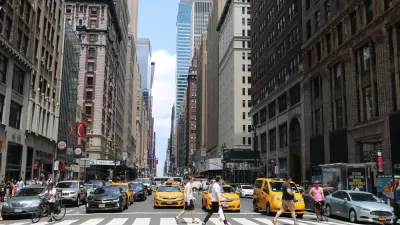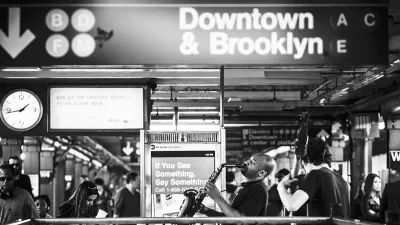The real estate intervened, and a proposed pied-à-terre tax became a mansion tax.

Ben Adler explains what happened to the proposed pied-à-terre tax that "would have generated $471 million a year, half of which would have come from just 280 homes worth more than $25 million," according to Wall Street Journal analysis. Analysis by New York City Comptroller Scott Stringer placed that number closer to $650 million a year.
According to Adler, that amount of funding was necessary to cover the gap between the potential revenue generating power of the city's proposed congestion pricing scheme, which could raise $15 billion over ten years toward an estimated $40 billion in required repairs to the MTA.
Instead of the proposed pied-à-terre tax, the New York Legislature and Governor Andrew Cuomo approved a tax that will have a broader impact but generate less funding. The 'mansion tax' will place a "surcharge on anyone buying a home in New York City for over $2 million and raising the real estate transfer tax on homes selling for more than $3 million." According to Adler, the Mansion tax will raise $365 million per year on average, an average subject to the whims of the real estate market in any given year.
Adler focuses much of the article on what was lost in the decision to change the pied-à-terre tax to a mansion tax; "the pied-à-terre tax would have killed three birds with one stone: raising revenue, revitalizing neighborhoods and reducing the obscene cost of housing."
For more on how the pied-à-terre tax became a mansion tax, see earlier news coverage by Vivian Wong.
FULL STORY: Pied-à-terre tax died for ridiculous reasons

Alabama: Trump Terminates Settlements for Black Communities Harmed By Raw Sewage
Trump deemed the landmark civil rights agreement “illegal DEI and environmental justice policy.”

Study: Maui’s Plan to Convert Vacation Rentals to Long-Term Housing Could Cause Nearly $1 Billion Economic Loss
The plan would reduce visitor accommodation by 25% resulting in 1,900 jobs lost.

Why Should We Subsidize Public Transportation?
Many public transit agencies face financial stress due to rising costs, declining fare revenue, and declining subsidies. Transit advocates must provide a strong business case for increasing public transit funding.

Paris Bike Boom Leads to Steep Drop in Air Pollution
The French city’s air quality has improved dramatically in the past 20 years, coinciding with a growth in cycling.

Why Housing Costs More to Build in California Than in Texas
Hard costs like labor and materials combined with ‘soft’ costs such as permitting make building in the San Francisco Bay Area almost three times as costly as in Texas cities.

San Diego County Sees a Rise in Urban Coyotes
San Diego County experiences a rise in urban coyotes, as sightings become prevalent throughout its urban neighbourhoods and surrounding areas.
Urban Design for Planners 1: Software Tools
This six-course series explores essential urban design concepts using open source software and equips planners with the tools they need to participate fully in the urban design process.
Planning for Universal Design
Learn the tools for implementing Universal Design in planning regulations.
Smith Gee Studio
Alamo Area Metropolitan Planning Organization
City of Santa Clarita
Institute for Housing and Urban Development Studies (IHS)
City of Grandview
Harvard GSD Executive Education
Toledo-Lucas County Plan Commissions
Salt Lake City
NYU Wagner Graduate School of Public Service





























